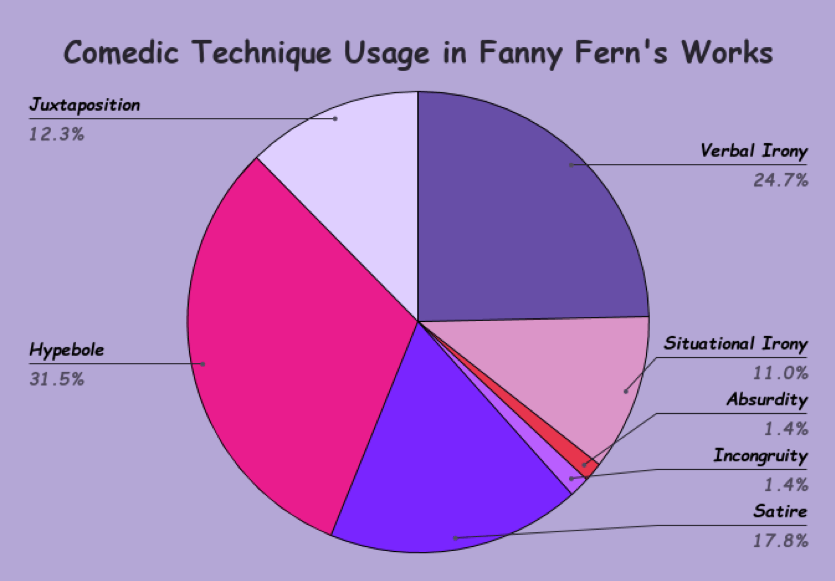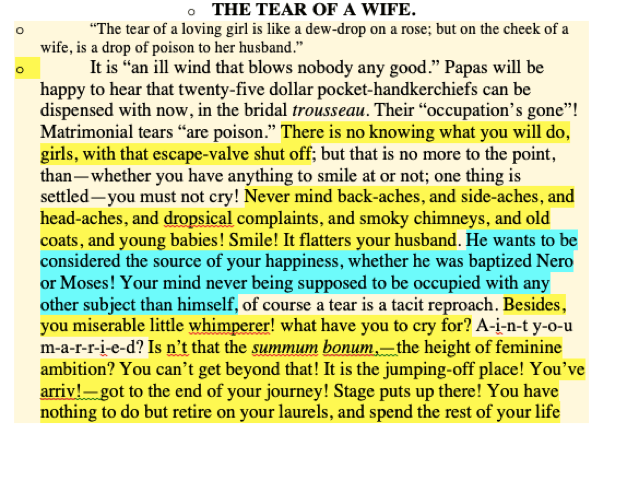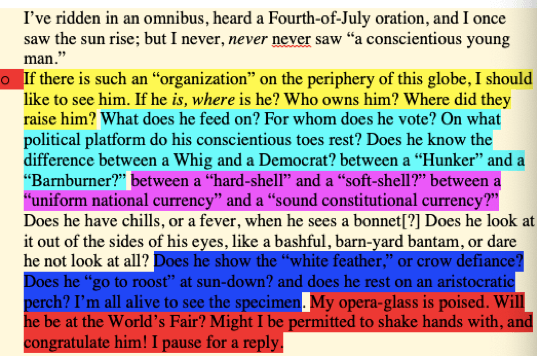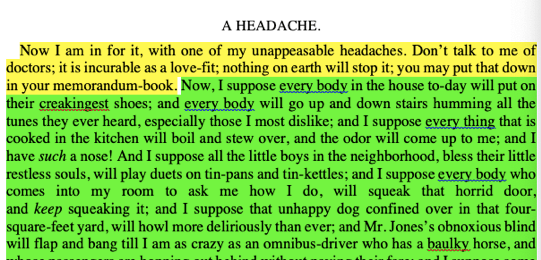Fanny Fern: Queen of Comedy
Fanny Fern is arguably one of the most important writers in early American history. Known for her wit and moving prose, she easily became the highest-paid columnist in the country by 1855, earning $100 per column in the New York Ledger. Her column collections, such as Fern Leaves from Fanny’s Portfolio and Folly as it Flies were rightfully bestsellers.
My project takes a look into her comedic techniques specifically, but before I get into that, allow me to talk a little more about Fanny herself.
Sara Willis (July 9th, 1811-October 10th, 1872) had been writing long before she would become the famed Fanny Fern. She had pieces published in her local newspaper and often wrote and edited articles for The Puritan Recorder and The Youth’s Companion, her father’s Christian newspapers. She published her first professional article for Olive Branch in 1851, in an effort to support herself and her daughters after the death of her first husband and the divorce of her second husband (due to his insane jealousy and abuse). She soon began using Fanny Fern as her pen name for all her articles. When she began to crack down and write more seriously in 1852, she was rejected by her brother Nathaniel, a magazine owner at the time, and received no support elsewhere in her family. Luckily other magazines and newspapers recognized her talent and began printing her columns, leading to her being hired to work exclusively for the New York paper Musical World and Times that summer.
She published six column collections, a novella, two novels, and three children’s books before she finally died of cancer at 61. Her works were “extremely successful,” with her conversational style resonating with the many women who read the weekly literary papers. She addressed topics like unfaithful husbands, restricting social customs, suffrage, and the occasional headache. While this is what made her so popular, “women’s literature” critics found her style unprofessional and “sentimental.” Of course these critics were men who, probably, were bitter that a woman could be good at something, let alone fantastic.
As an aspiring writer myself, her story and success intrigued me. Since there are so many parts to her style, however, I decided to focus on her humor alone. Personally, comedy writing poses quite a challenge, so I wanted to see how someone as revered as Fanny approached it. I took pieces from her column collections and took a count of how many times a comedic technique was used per piece. Here is what my labor has produced:

Let me break this down for you.
There are various techniques used in comedy that I have identified in Fern’s various works throughout her career. Though I researched more than these on the chart, these are the only ones I found her using. I’ll analyze her usage of each from the bottom up.
Incongruity is when something is out of place or not in its usual environment, or when someone is acting out of character. Similar to this is absurdity, which is the wrong/improper use of examples. These both are presented best in a list, and so would be difficult to make frequent use of without losing the humorous effect. So the fact that they are used the least isn’t surprising.
Situational irony is when the opposite of what’s expected happens. This is something you can play around with more. My favorite use of this technique is in the piece “Headache” from Fresh Leaves (1857). Here’s a sample:
“Now, I suppose every body in the house to-day will put on their creakingest shoes; and every body will go up and down stairs humming all the tunes they ever heard, especially those I most dislike…”
Much of the piece is like this, with Fern supposing that everyone will be doing the most headache-inducing things coincidentally on the day she has the worst headache imaginable. This technique is great for someone who writes about things from her daily life, as it can be applied to more situations than a bad headache. Life itself is often ironic, and, living in an age where men and society as a whole are even more contradictory and ridiculous than today, Fern can more easily use that to her advantage.
Juxtaposition compares two different things by just placing them together, often because they are so dissimilar that it’s unexpected. Fern mostly uses this in the context of discussing aspects of Boston versus aspects of New York, both places she lived in for a significant amount of time. What’s funny about this specifically is how they’re both so different from each other, but somewhat inconsistently. One is finicky over dress but not manners, while the other may be the opposite, things of that sentiment. Fern uses this slightly more than situational irony, I feel, because she has such intimate knowledge of both New York and Boston that she can pick out these differences that simple visitors may not. However, this isn’t something that can be used in a wide variety of situations. You can’t compare two random things and have it be funny. It has to be thought out. So while juxtaposition is of more use to Fern, it’s still pretty restricting.
Satire is humor that mocks society or human faults and weaknesses. Given that this is the 1800s, and society is much more flawed than it is today, and that Fern was not only a woman during this period, but a successful writer, there was a lot of material that she had to work with. As such, a good portion of her work contained satire to varying degrees. In fact, this may be a big influence on the negative press she got from critics. Have you ever tried implying that a man might be wrong about something? It rarely goes well. It is, however, hilarious when done properly. One example I like if from a piece titled “Why Wear Mourning?” in the collection Ginger-Snaps:
“Is real heart-breaking grief to be gauged by the width of a hem, or the length or thickness of a veil?”
This one is mostly about the ridiculous ways the “wealthy” mourn the death of a loved one. This is something that holds up today, I think (not to wealth-shame anyone, but rich people are still wild), and as many of Fern’s readers were working or lower class women, it would resonate with them as well. And, as I’ve said, there were a lot of things like this to make fun of in Fern’s time, making satire an important asset to her writing.
Verbal irony, or sarcasm, is when what’s being said is the opposite of what is meant. There’s a big jump in usage from satire, nearly a whopping 7% difference. This is because, since sarcasm has little rules, it is much easier to pepper into writing. You can use sarcasm in virtually every situation that isn’t somber. I found it in nearly every piece that I looked at. There’s not much really to say on this because it’s such a simple thing. I will add, though, that the usage of an easy technique may have also been a part of her criticisms (critics often like to feel high and mighty about things, and may have scorned the lack of sophistication that comes with sarcasm).
Hyperbole the intentional exaggeration of statements. I was a bit surprised to learn that this is what makes up the biggest chunk of Fern’s comedy, as it isn’t as flexible as sarcasm. I do understand it, though. While sarcasm is easier to use, it isn’t always as funny as hyperbole can be. For example, from “Moral Molasses” of Fresh Leaves:
“These guide books are mainly written by sentimental old maids; who, had they ever been within kissing distance of a beard, would not so abominably have wasted pen, ink, and paper; or, by some old bachelor, tip-toeing on the outskirts of the promised land, without a single clear idea of its resources and requirements, or courage enough to settle there if he had.”
Taking something this far and making it over the top is what puts emphasis on how Fern feels about the writers she is talking about. That’s more than what sarcasm can do, which is usually just imply that something is stupid. Fern’s big ticket to success is her conversational tone, and conversation can become funny, which is a quality that many people appreciate. So it makes sense that, to get the best response, Fern uses what’s funniest the most. But it’s important to note that she never pushes her boundaries with it. It’s used thoughtfully and without excess. It’s perfect.
To be quite honest, I wasn’t so sure that I’d actually learn anything useful or interesting through this project. I thought I’d get a more “oh that’s cool” kind of feeling. I’m happy to say that I am pleasantly surprised to have gathered so much from some statistics. Putting this together required that I comb through Fern’s different works and find good ones to use for this project, which let me get a closer feel to how she writes and how much of her writing is comedy versus advice versus prose (it’s a good mix). Through analyzing the techniques she used, I’ve come to have a better understanding of what may have driven her to use each one at certain times. A lot of the other techniques I researched, as it turns out, wouldn’t work for a written medium, like slapstick or mistaken identity. She also rarely (if ever) uses self-deprecating humor, which is a bold testament to how seriously she (and how others should have) took herself as a writer and an individual. I’ve come to respect her, actually. I may have to take a few pages from her book with my own writing.
Fanny Fern: A Process
I chose to focus my project on the works of Fanny Fern for a few different reasons. 1) She lived and wrote in the 1800s, which made her writing significantly easier to understand than that of writers from earlier in history. 2) She was a woman writer, and an extremely successful one at that. 3) She’s funny! I genuinely enjoyed reading her work.
I myself am studying to become a fiction writer, and I tend to use a more conversational and colloquial style, much like Fanny Fern does. It’s a good way of connecting to the readers, as Fern’s success has proven. So to hear that there was someone with similar aspirations way back then, it was instantly a point of interest for me. Especially since her use of comedy is so well done, which can be really hard to accomplish in writing. That’s why I decided to inspect her humor specifically, as opposed to, say, her prose. It’s unique.
I started off with a quick visit to Wikipedia to find out just how much Fern had written. I stuck to her six column collections, rather than her novels and children’s books, as they were what gave her popularity (and because I could only read so much). The collections are titled as follows: Fern Leaves from Fanny’s Portfolio (1853), Fern Leaves from Fanny’s Portfolio: Second Series (1854), Fresh Leaves (1857), Folly as it Flies (1868), Ginger-Snaps (1870), and Caper-Sauce (1872). I combed through each collection (provided by the internet, thankfully for free) and chose a couple pieces to analyze for comedy techniques. Here are a few screenshots of the pieces in my notes:


You can see that I have made use of the many colors of the highlighter to keep track of techniques (no, the colors have no meaning, I just wanted to distinguish between different techniques in a piece).
I then had to figure out exactly what techniques I was looking for. After cross-referencing a few sources, I came up with the following techniques: repetition, hyperbole, understatement, double entendre, puns, juxtaposition, mistaken identity, taboo, slapstick, verbal irony, situational irony, dramatic irony, parody, absurdity, incongruity, oxymoron, self-deprecating, screwball, and satire. That’s nineteen different techniques used for comedy. I ended up only detecting seven of them in Fern’s works.
And how did I come to that? Well, it was really just me going through and reading each of the works I selected and picking out techniques as I spotted them. I used excel to keep track of them. Here’s a small portion of it: After that I used Google Docs to convert the numbers into percentages and make the pie chart that is the face of my project. Here it is again:
After that I used Google Docs to convert the numbers into percentages and make the pie chart that is the face of my project. Here it is again:

The colors don’t mean anything here either; I just think picked what I think looks nice (obviously I am a fan of both pink and purple).
Though there were only a few steps involved in this process, don’t think that this was easy or it wasn’t time consuming. Because trust me, it was. Choosing pieces to read alone took several hours that stretched over many different days. It took so long because there’s just so much content crammed into six volumes, with Folly as it Flies having a particular affinity for very long pieces. You have no idea how exhausting it was just to see that many words.
It also proved a bit difficult to determine which techniques were being used at certain times. Oftentimes there would be a sentence or a paragraph that was definitely funny, but I couldn’t quite tell what it was that made it funny. I worked alone on this project, so I tried my best to reason through it and eventually assign a technique to it. In addition to that, choosing what counted at one usage of a technique took some internal debate. I settled on every complete thought, rather than singular sentences. That made it easier to translate that to a numerical value.
Turning those values into a chart was easy. I used Google Docs because Excel was giving me a technologically hard time. But it ended up not being a problem. I got to choose the font and the colors and how and where the percentages would be presented. I did not, however, figure out how to change the color of the percentages themselves. Thankfully, they’re still visible, so it’s not a big deal.
Now, originally, I was going to use a line graph to show the change in usage of techniques over time. When I was working on collecting the data, though, I realized this wasn’t enough for me to do that. If I wanted to go along with my starting idea, I’d have to have used many more works than the twelve I used, and I just didn’t have the time for that. Plus, I think analyzing her work as a whole, rather than over time, is more beneficial to both myself and anyone seeking to learn about Fanny Fern. When I think about it, I don’t know what anyone would use that information for, unless to compare to changes in reviews. But even then, what would be the use?
If I had the time, or perhaps some help, I would have liked to use a bigger sample of Fern’s work to make a more accurate analysis of her style and techniques. It’s a basic rule of statistics that the bigger the sample, the more accurate the results. But I’m only one person, and I had to do other work besides this project, being a student and all. Time isn’t ever something I have a lot of. For what time and resources I did have, though, I’m proud of what I came up with! I put a lot of effort and thought into how to construct and present this project. I think it’s a good reflection of that labor and what I gained from it. And my pie chart is pretty!